Introduction
Have you ever wondered whether rabbits have a thing for strawberry plants? I mean, those cute little creatures hopping around your garden, munching on everything in sight – do they specifically target strawberry plants as their go-to snack?
So, let’s dive into the world of rabbits, their eating habits, and their undeniable attraction to strawberry plants. Together, we’ll unravel this mystery once and for all!
Before we get to the strawberry dilemma, let’s start by understanding what rabbits actually eat. These furry fellows are herbivores, which means their diet consists mainly of plant material.
From grass and hay to leafy greens and vegetables, rabbits have a diverse menu. And yes, that includes fruits like strawberries.
Now, when it comes to strawberries, rabbits seem to have a particular fondness for the leaves. Those lush, green strawberry leaves are like a delicacy to them.
But what about the actual fruit? Do rabbits target the juicy red berries too?
While rabbits do have a varied diet that includes fruits, their preference for strawberry leaves seems to outweigh their interest in the fruit itself. There are a few reasons for this.
The fruit, on the other hand, dangles from the plant and is less within reach. Plus, the leaves provide better nutrition for rabbits, packed with vitamins and other essential nutrients.
Rabbits also have a knack for being selective eaters. They know which parts of the plant are the most nutrient-rich, and they focus on those parts for their meals.
This instinct leads them to prioritize the leafy portion of the strawberry plant over the fruit itself.
Understanding rabbit behaviors and preferences adds another layer to this puzzle. These small foragers spend a significant amount of time searching for food, nibbling on vegetation close to the ground.
So, while strawberries might be a treat for them, they also want to explore other food options to ensure a well-rounded meal.
Now that we’ve peeked into the world of rabbits and their eating habits, it’s time to explore ways to protect your precious strawberry crop from these cheeky nibblers. Don’t worry; we’ve got you covered!
Happy gardening!
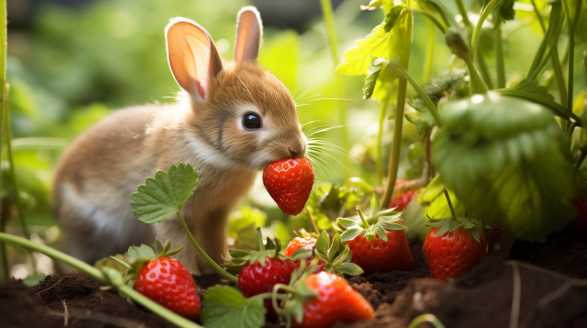
Key Takeaways
- Rabbits are herbivores and their diet consists mainly of plant material, including fruits like strawberries.
- While rabbits have a preference for strawberry leaves, they may also nibble on the fruit itself, but in moderation due to its higher sugar content.
- Rabbits are selective eaters and prioritize the most nutrient-rich parts of plants, which often include the leaves of strawberry plants.
- Rabbits spend a lot of time foraging and prefer vegetation close to the ground, such as grass and leaves.
- To protect strawberry plants from rabbit damage, strategies like fencing, netting, natural deterrents, and providing alternative food sources can be employed.
- Identifying symptoms of rabbit damage on strawberry plants includes bite marks, trimmed vegetation, damaged fruits, and disturbed soil.
- It is important to consider the balance between protecting strawberry plants and coexisting with rabbits in a sustainable manner.
Do Rabbits Only Eat Strawberry Leaves, or Do They Target the Fruit Too?
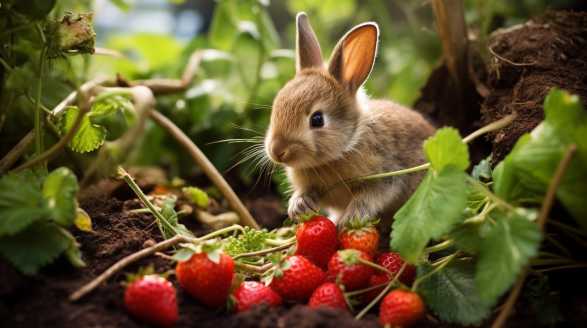
As I sit here in my backyard, observing the rabbits hopping around, I can’t help but wonder – do rabbits only eat strawberry leaves, or do they have a taste for the fruit as well? It’s a perplexing question that has left me scratching my head for quite some time.
Join me as we explore whether rabbits are solely interested in strawberry leaves or if they dare to target the fruit too!
What do rabbits eat?
Before we dive into the strawberry dilemma, let’s lay the groundwork by understanding what rabbits typically eat. Rabbits are herbivores, which means their diet consists mainly of plant material.
Here’s a list of some common foods found in a rabbit’s menu:
- Grass
- Hay
- Leafy greens (such as lettuce, spinach, and kale)
- Vegetables (such as carrots, broccoli, and cauliflower)
- Herbs (such as parsley, cilantro, and basil)
- Twigs and bark
- Fruits (including strawberries)
The allure of strawberry leaves
Strawberry plants are undoubtedly a treat for rabbits. The juicy green leaves provide a succulent grazing option, which rabbits find hard to resist.
Rabbits are clever creatures, and they know exactly which parts of the plant are the most nutrient-rich. Thus, strawberry leaves become an instant favorite due to their flavor and nutritional content.
Do rabbits target the strawberry fruit?
Now, let’s address the million-dollar question – do rabbits also target the strawberry fruit? Well, the answer is not as clear cut as one might think.
Here are some reasons why rabbits don’t typically target the fruit:
- Leafy greens are more accessible: Rabbits are ground-dwelling animals, and strawberry leaves are easily within their reach. On the other hand, strawberry fruits are usually found hanging off the plant, making them less accessible to rabbits.
- Leaves provide better nutrition: Strawberry leaves are packed with vitamins and other vital nutrients that rabbits need to maintain a healthy diet. The leaves are like a nutritional powerhouse, while the fruit is more sugary and does not offer the same level of nutritional value.
- Fruit consumption in moderation: Rabbits, like any other herbivore, should consume fruits in moderation due to their high sugar content. Therefore, rabbits instinctively regulate their fruit intake and focus more on the leafy portion of the plant, which provides a more balanced diet.
Rabbit behaviors and preferences
Apart from their dietary habits, understanding rabbit behaviors and preferences can shed further light on their affections for strawberry leaves over the fruit. Here are some interesting facts:
- Foraging behavior: Rabbits are natural foragers and spend a significant amount of time searching for food. They nibble on the vegetation closest to the ground, such as leaves and grass. This behavior aligns with their preference for strawberry leaves rather than the fruit.
- Selective feeding: Rabbits are selective eaters, meaning they prefer certain parts of a plant over others. For example, they often consume the succulent stems and leaves but ignore the fibrous core. This selectiveness may explain why rabbits are more inclined to eat strawberry leaves rather than the fruit.
- Variety is the spice of life: Although rabbits love strawberry leaves, they crave variety in their diet. By diversifying their food choices, rabbits can ensure they receive a broader range of nutrients. This desire for variety could be another reason why strawberries alone do not monopolize their menu.
How to protect your strawberries from rabbits?
Now that we’ve unraveled the mystery surrounding rabbits’ penchant for strawberry leaves rather than the fruit itself, let’s explore some strategies to protect your precious strawberry crop from these voracious nibblers. Here are some tried and tested methods:
- Fencing: Installing a fence around your strawberry patch can create a physical barrier that rabbits find difficult to breach. Ensure the fence is buried at least 6 inches deep to prevent rabbits from digging underneath.
- Netting: Covering your strawberry plants with netting or mesh can block rabbits from reaching the fruit while still allowing sunlight and airflow. Be sure to secure the netting tightly to prevent any gaps that rabbits could slip through.
- Natural deterrents: Rabbits dislike certain scents, such as garlic, onions, and vinegar. Use these natural repellents around your strawberry plants to discourage rabbits from approaching. Additionally, planting rabbit-resistant flowers, like marigolds and nasturtiums, can act as a visual deterrent.
- Alternative food sources: Provide rabbits with alternative food sources in a separate area of your garden to divert their attention away from your precious strawberries. By offering them a delicious buffet, you may reduce their temptation to target your strawberry patch.
In the debate over whether rabbits only eat strawberry leaves or also target the fruit, it’s clear that their preference lies with the leaves. While rabbits do have a broad diet that includes fruits, strawberry leaves are the primary target due to their accessibility, nutritional value, and lower sugar content.
So, if you’re a strawberry enthusiast concerned about your crop, take heart! By implementing the aforementioned protective measures, you can create a rabbit-proof environment and safeguard your luscious strawberries from furry intruders.
The Complete Guide to Protecting Your Strawberry Plants from Rabbit Damage
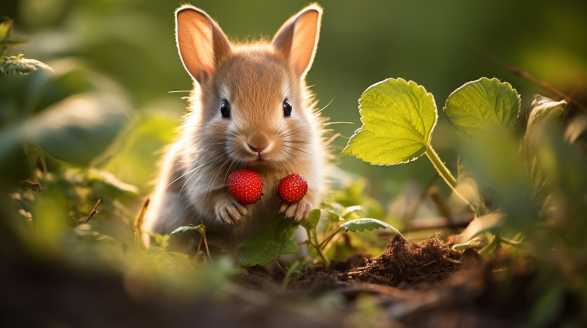
There is nothing more frustrating for a gardener than waking up in the morning only to find that rabbits have devoured your beloved strawberry plants. These adorable creatures can be a real nuisance, but fear not!
So, let’s hop right in!
Understanding the Rabbit Munching Menace
Rabbits are notorious for their love of tender plants, and strawberries are no exception. These fluffy critters can wreak havoc on your strawberry patch by nibbling on leaves, stems, flowers, and even the juicy fruits themselves.
Creating a Rabbit-Proof Barrier
Building a physical barrier is one of the most effective ways to protect your strawberry plants from rabbit damage. Here are some methods you can employ:
- Wire Fencing: Surround your strawberry patch with sturdy, galvanized wire fencing. Make sure the fence is at least two feet high and bury the bottom edge at least six inches underground to prevent rabbits from burrowing underneath.
- Netting or Chicken Wire: If you have a smaller garden or just a few potted strawberry plants, covering them with netting or chicken wire can deter rabbits from getting to them. Be sure to secure the edges tightly to prevent any gaps.
- Cylinder Guards: Create individual wire mesh cylinders around each strawberry plant to protect them individually. These can be especially useful if you’re dealing with a persistent rabbit who manages to find weak spots in your larger barriers.
Natural Deterrents for Rabbits
If you prefer to avoid using physical barriers, you can try using natural deterrents to keep rabbits away from your strawberry plants. Here are some methods you can try:
- Predator Urine: Believe it or not, rabbits are scared of predators! Apply predator urine around your strawberry plants to deter rabbits. You can find commercially available predator urine, such as fox or coyote urine, at garden centers or online.
- Strong Odors: Rabbits have a keen sense of smell, and certain scents can repel them. Consider sprinkling cayenne pepper, dried blood meal, or garlic powder around your plants to deter rabbits. Keep in mind that you may need to reapply these substances after rain or watering.
- Plants Rabbits Dislike: Some plants have natural compounds that repel rabbits. Consider planting rabbit-resistant flowers or herbs, such as marigolds, lavender, or thyme, around your strawberry patch. Not only will these plants help keep rabbits away, but they can also add beauty and fragrance to your garden.
Additional Tips for Rabbit-Proofing Your Garden
Here are some additional tips and tricks to ensure maximum protection for your strawberry plants:
1. Regularly Inspect and Repair Fences
Inspect your protective barriers regularly for any signs of damage or gaps. Repair any holes or weak spots promptly to prevent rabbits from finding their way into your strawberry patch.
2. Remove Potential Rabbit Hideouts
Rabbits love hiding in tall grass, shrubs, and dense vegetation. Eliminate these hiding spots around your garden to discourage rabbits from taking up residence nearby.
3. Keep Your Garden Clean and Tidy
Remove fallen fruits, debris, and excess mulch from your garden. These can provide tempting nibbles for rabbits while also attracting other pests.
4. Consider Natural Predators
Introducing natural predators, such as domestic cats or dogs, or even installing a motion-activated sprinkler system, can help scare away rabbits from your garden. However, always ensure the safety and welfare of any animals you choose to include in your garden protection strategy.
5. Add Visual Deterrents
Rabbits are skittish creatures, so anything that simulates movement or unknown objects can make them wary. Consider placing scarecrows, reflective objects, or wind chimes around your strawberry patch to deter rabbits.
Protecting your strawberry plants from rabbit damage doesn’t have to be a daunting task. By implementing the tips and techniques outlined in this guide, you can create a formidable defense against these furry intruders.
With a little perseverance and creativity, you can enjoy the fruits of your labor and keep rabbits at bay. Happy gardening!
Taking a Closer Look at Rabbit Damage: Identifying Symptoms on Strawberry Plants
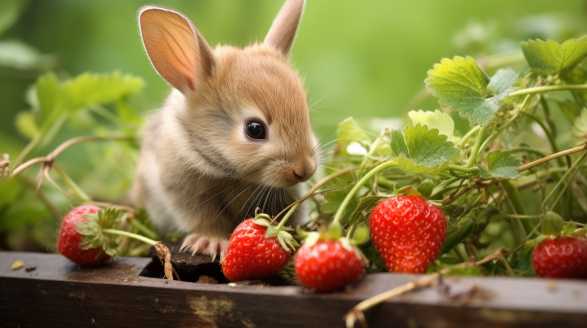
As a passionate gardener, I have encountered my fair share of challenges in maintaining the health and beauty of my plants. Among these challenges, rabbit damage has proven to be quite perplexing and frustrating.
we will look into the world of rabbit damage and explore the telltale signs of their presence on strawberry plants.
What are the Symptoms of Rabbit Damage on Strawberry Plants?
If you suspect rabbit damage on your strawberry plants, it is essential to quickly identify the symptoms to take appropriate action. Here are some common signs that indicate rabbits may be feasting on your precious strawberry plants:
- Bite Marks: Rabbits have sharp teeth that leave distinct bite marks on strawberry plant leaves, stems, and even fruits. These bite marks may appear as irregular, jagged edges or neatly cut sections.
- Trimmed Vegetation: Rabbits are meticulous eaters and often prefer to graze close to the ground. If you notice neatly trimmed foliage or short stubs where leaves and stems once existed, rabbits may be the culprits.
- Dry, Damaged Fruits: Rabbits have a particular fondness for strawberry fruits. They may nibble on the ripe berries, leaving behind chewed or damaged areas, which can quickly lead to rotting or insect invasions.
- Disturbed Soil: Rabbits are also notorious for burrowing. If you notice small holes or disturbed soil near your strawberry plants, it is a good indication that rabbits are present in your garden.
How to Protect Your Strawberry Plants from Rabbit Damage
Now that we can identify the symptoms of rabbit damage on strawberry plants, let’s explore effective measures to protect our cherished crops. Implementing these strategies will help you enjoy the fruits of your labor without interference from these furry garden pests:
Fencing
Use Chicken Wire or Hardware Cloth
One of the most effective ways to deter rabbits from reaching your strawberry plants is to install a barrier. Chicken wire or hardware cloth with small openings (about 1 inch or less) should be securely installed around the area where your strawberries are growing.
Consider Adding a Roof
Rabbits are agile jumpers and can easily reach plants above their height level. To address this, consider adding a roof-like structure to your fencing system, which will deter rabbits from leaping over the top and into your strawberry patch.
Natural Deterrents
Plant Rabbit-Repelling Herbs
Certain herbs have natural scents that repel rabbits. These include lavender, mint, sage, and rosemary.
Utilize Citrus Peels
Rabbits have a strong aversion to citrus scents. By placing citrus peels from oranges, lemons, or grapefruits near your strawberry plants, you can create a natural deterrent.
Companion Planting
The Power of Marigolds
Marigolds are a popular companion plant for strawberries, as they attract beneficial insects while repelling harmful ones. Additionally, rabbits tend to avoid areas filled with marigolds due to their distinct scent.
Ornamental Grasses
Ornamental grasses, such as pampas grass or fountain grass, can create a physical and visual barrier around your strawberry plants. Rabbits generally avoid these plants due to their tall and sharp foliage, providing an extra layer of protection for your cherished crop.
Maintain a Clean Garden
Rabbits are attracted to messy gardens that provide ample hiding spots. By keeping your garden clean and tidy, you can make it less appealing to these furry intruders.
Rabbit damage on strawberry plants can be a frustrating setback for avid gardeners. However, by identifying the symptoms and implementing effective protection strategies like fencing, natural deterrents, companion planting, and maintaining a clean garden, you can minimize the impact of these garden pests, allowing your strawberry plants to thrive and produce a bountiful harvest.
Are Strawberry Plants a Favorite Treat for Wild Rabbits? Discover the Truth
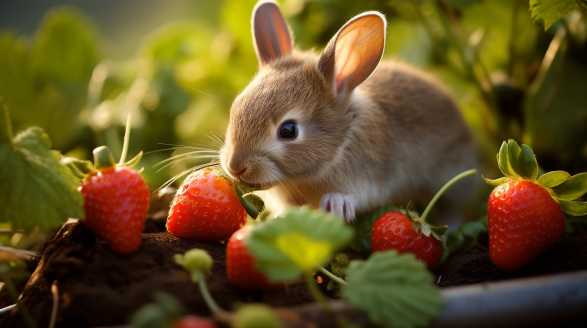
As a nature enthusiast and avid gardener, I have always been fascinated by the delicate balance between wildlife and our precious plants. One question that has often crossed my mind is whether wild rabbits have a penchant for devouring strawberry plants.
I will look into the truth behind this popular belief, separating fact from fiction. So, let’s embark on this rabbit-hole of discovery together, and put an end to the mystery!
The Appeal of Strawberries for Rabbits
Strawberry plants are indeed a sight to behold in any garden, inviting both humans and animals alike with their vibrant colors and tantalizing aroma. It is therefore not surprising that keen-eyed rabbits would be drawn to these luscious fruits.
Here are some reasons why rabbits find strawberry plants irresistible:
- Delectable Foliage: The leaves of strawberry plants, with their tender texture and mildly sweet flavor, are a delicacy for rabbits. They are an excellent source of vital nutrients, including fiber, vitamin C, and antioxidants.
- Moisture-packed Treats: In addition to nourishing leaves, rabbits are also attracted to the high water content in strawberry fruits. This can be particularly enticing for them, especially during dry spells or in arid regions.
- Natural Foraging Behavior: Rabbits are natural foragers, constantly on the lookout for fresh greens and fruits. The bright red color of strawberries catches their attention and triggers their instincts to explore and nibble on these appetizing plants.
Rabbit-Proofing your Strawberry Patch
Now that we understand the allure of strawberry plants for wild rabbits, it’s time to shift our focus to protecting your cherished crop from their insatiable appetite. Here are some practical tips to rabbit-proof your strawberry patch:
1. Install Physical Barriers
The most effective way to keep rabbits at bay is by establishing physical barriers. You can erect a wire mesh fence around your strawberry patch, burying it a few inches into the ground to discourage burrowing.
2. Utilize Natural Deterrents
Rabbits have a keen sense of smell and are deterred by certain strong scents. Consider using natural deterrents, such as garlic or dried blood meal, around your strawberry plants.
3. Plant Rabbit-Resistant Flowers
Certain flowers possess natural compounds that rabbits find unappealing. By interspersing your strawberry plants with these rabbit-resistant flowers, such as marigolds or pungent herbs like rosemary, you can create a barrier around your patch while adding visual appeal to your garden.
4. Implement Scare Tactics
Rabbits are cautious creatures and startle easily. Taking advantage of this instinct, you can place motion-activated sprinklers or wind chimes near your strawberry plants.
Coexistence with Rabbits: A Sustainable Approach
While implementing these measures can help protect your strawberry plants, it’s important to remember that rabbits are an integral part of our ecosystems. Rather than perceiving them as mere pests, adopting a sustainable approach to coexistence can benefit both our gardens and wildlife.
Provide Alternative Food Sources
One reason rabbits may target your strawberries is the lack of other desirable food options nearby. By setting up a separate feeding station stocked with rabbit-friendly plants, such as clover or dandelion greens, you can divert their attention from your precious strawberries.
Create Habitat Diversity
Rabbits thrive in habitats rich in diversity. Planting a variety of vegetation in your garden can attract a wide range of plant species and insects, providing rabbits with alternative food sources.
Embrace Coexistence
It’s important to remember that our gardens are part of the natural world. Sometimes, despite our best efforts, rabbits may still manage to enjoy a few choice strawberries.
After exploring the complex relationship between wild rabbits and strawberry plants, we can conclude that while rabbits do indeed find them appealing, they can be deterred with the right strategies. By employing physical barriers, natural deterrents, and incorporating coexistence into our gardening practices, we can strike a balance that ensures our strawberry plants flourish while allowing rabbits to thrive in harmony with their natural instincts.
Understanding the Eating Habits of Rabbits: Do They Target Strawberry Plants?
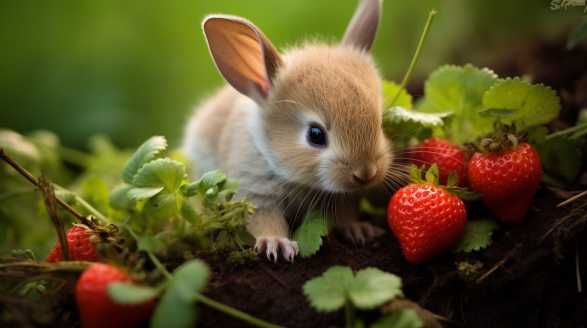
When it comes to understanding the eating habits of rabbits, there are many questions that arise. One particular concern for gardeners and strawberry enthusiasts is whether rabbits specifically target strawberry plants as a source of food.
Rabbit’s Diet: An Overview
Rabbits are known for being herbivorous creatures, meaning they primarily consume plant-based materials. Their diet consists of various types of grasses, hay, green plants, vegetables, and even fruits.
Preferences and Tastes of Rabbits
A Varied Palette
Rabbits, like humans, have their own unique tastes and preferences when it comes to food. While some rabbits might relish certain varieties of fruits and vegetables, others may completely ignore them.
Leafy Greens: A Rabbit’s Delight
One thing that can be agreed upon is a rabbit’s love for leafy greens. They have a keen affinity for fresh, crunchy greens such as spinach, lettuce, and cilantro.
Fruits: A Treat or Temptation?
Fruits are generally seen as occasional treats for rabbits, as they tend to be higher in sugar content. However, some rabbits do have a sweet tooth and may thoroughly enjoy nibbling on fruits such as apples, bananas, and even strawberries.
Rabbit’s Relationship with Strawberry Plants
Now that we have a general understanding of a rabbit’s diet, let us explore whether strawberry plants are a target for these fluffy creatures.
Strawberry Plants: A Juicy Delicacy?
Strawberries are undoubtedly a delectable fruit that humans crave, but do rabbits feel the same way? The answer ultimately depends on the individual rabbit and its preferences.
While some rabbits may show interest in strawberry plants due to their sweet scent and juicy taste, others may not find them as appealing. Rabbits tend to be selective eaters and might have their own set of favorite foods.
Alternative Factors
However, it’s important to consider other factors that might drive rabbits to target strawberry plants. For instance, if no other food sources are available or if the garden or surrounding area lacks diverse plant options, rabbits may resort to nibbling on strawberry plants out of necessity rather than preference.
Protection and Deterrence
If you’re concerned about rabbits damaging your strawberry plants, there are steps you can take to protect them. Here are some deterrent measures you can consider:
- Install a fence around the garden area to keep rabbits at bay.
- Apply natural repellents such as garlic or onion sprays around the strawberry plants.
- Use physical barriers like mesh or netting to prevent rabbits from reaching the plants.
- Plant rabbit-resistant species alongside strawberry plants to divert their attention.
Understanding the eating habits of rabbits can be complex. While rabbits are herbivores with a preference for leafy greens, their appetite for fruits can vary.
Taking precautions and implementing deterrent measures can help protect strawberry plants from potential rabbit damage. Ultimately, gaining insight into the eating habits of rabbits assists in making informed decisions to coexist with these furry friends in our gardens.
Conclusion
In conclusion, the question of whether rabbits only eat strawberry leaves or also target the fruit itself is not as simple as it may seem. While rabbits are herbivores and do have a taste for fruits like strawberries, their preference tends to lean more towards the delicious leaves.
However, rabbits have an instinctual moderation when it comes to consuming fruits due to their higher sugar content. This instinct leads them to prioritize the leafy portion of the strawberry plant over the fruit itself.
Additionally, rabbits are selective eaters and have their own unique tastes, which can vary from rabbit to rabbit. They also have a natural penchant for variety in their diet, seeking out different food options to ensure a well-rounded meal.
To protect your strawberry plants from rabbit damage, there are several strategies you can employ. Building physical barriers like fences or netting can prevent rabbits from accessing your plants.
Providing alternative food sources or planting rabbit-resistant flowers nearby can also divert their attention away from your prized strawberries.
It is important to remember that while protecting your strawberry plants is essential, finding a balance between safeguarding your crops and coexisting with rabbits in a sustainable manner is equally crucial. Understanding the eating habits and preferences of rabbits enables us to employ strategies that not only protect our plants but also respect the natural instincts and behaviors of these furry garden visitors.
So, the next time you spot a rabbit nibbling on your strawberry patch, take a moment to appreciate the delicate dance between these animals and our garden. By implementing protective measures and embracing coexistence, we can enjoy the beauty of nature while still indulging in the delight of homegrown strawberries.
Frequently Asked Questions
Do rabbits eat strawberry plants?
Yes, rabbits are known to eat strawberry plants. They are attracted to the sweet fragrance and delicious taste of the leaves and fruits.
Are strawberry plants safe for rabbits to eat?
While strawberry plants are generally safe for rabbits to consume, it is important to note that the leaves, stems, and fruits may cause digestive issues if fed in excessive amounts. Moderation is key when offering strawberry plants to rabbits.
Can rabbits eat strawberry leaves?
Yes, rabbits can eat strawberry leaves. They are safe and nutritious for them, but should still be offered in moderation as part of a balanced diet.
Will rabbits destroy my strawberry plants?
Rabbits may nibble on strawberry plants and potentially cause damage. To protect your plants, it is recommended to use protective fences, barriers, or netting to prevent rabbits from accessing your garden.
How can I deter rabbits from eating my strawberry plants?
Some effective ways to deter rabbits from eating your strawberry plants include using repellents, installing motion-activated sprinklers, creating noise disturbances, and maintaining a clean garden free of tempting food sources. Alternatively, you can also grow plants that rabbits dislike, like marigolds or lavender, near your strawberry plants.
What other foods can I offer rabbits besides strawberry plants?
Rabbits have a diverse diet and can enjoy a variety of foods. In addition to strawberry plants, you can feed them timothy hay, fresh vegetables (e.g., carrots, lettuce, cilantro), leafy greens (e.g., spinach, kale), and pellets specifically formulated for rabbits.
Are there any plants that rabbits should not eat?
Yes, some plants are toxic to rabbits and should be avoided. These include, but are not limited to, azaleas, rhubarb leaves, potatoes, tomatoes, and onions. It’s best to research and ensure that any plants you offer your rabbit are safe for their consumption.
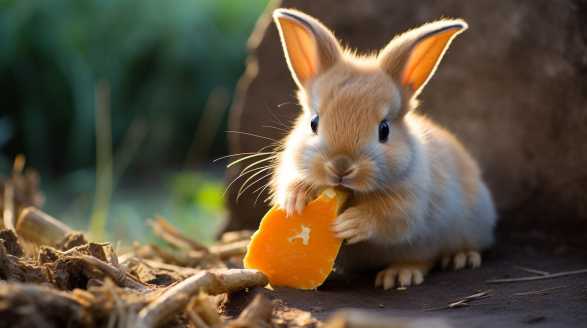
Can Rabbits Eat Sweet Potatoes
Introduction Can Rabbits eat sweet potatoes? Let’s find out.. I’ve always wondered if there’s more to our bunnies’ diet than just the usual hay and pellets. And boy, was I in for a surprise! I mean, who could resist the idea of providing their furry friend with a balanced and healthy diet? But here’s where […]
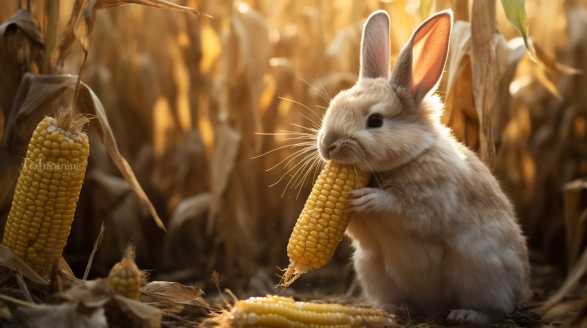
Can Rabbits Eat Corn
Introduction Hey there, fellow rabbit lovers! Are you ready to dive into the intriguing world of corn and its impact on our adorable furry friends? Let’s find out, can rabbits eat corn? Picture this: you’re snuggled up on the couch, surrounded by your fluffy companions, when suddenly the topic of corn comes up. You’ve heard […]
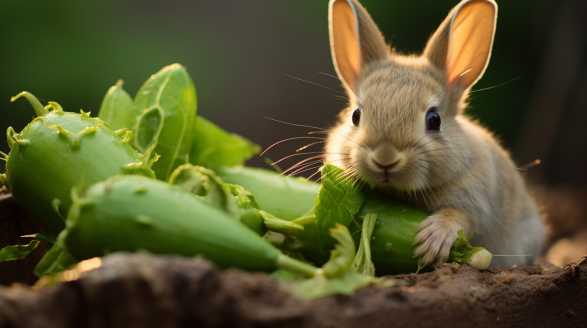
Can Rabbits Eat Okra
Introduction Can Rabbits eat okra? Let’s find out. We’re about to embark on an adventure filled with mysteries, health benefits, and the undeniable allure of okra for our furry friends. Picture this: you’re strolling down the vegetable aisle, and your eyes fall upon the vibrant green pods of okra. You’ve heard whispers about this veggie, […]
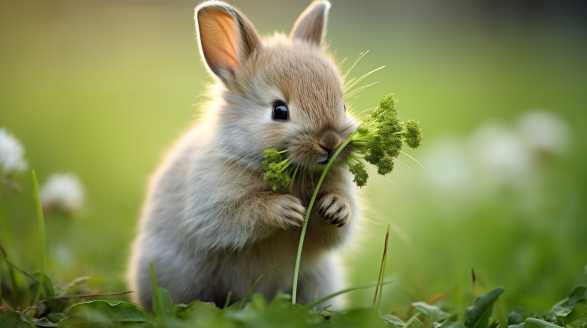
Can Rabbits Eat Chives
Introduction Can Rabbits eat chives? Let’s find out. Chives, those vibrant and aromatic herbs, may seem like a tempting choice to enhance our rabbit’s diet. But hold on to your bunny ears, my friends, because there’s a lot more to this story than meets the eye. From the incredible benefits of parsley and dill to […]
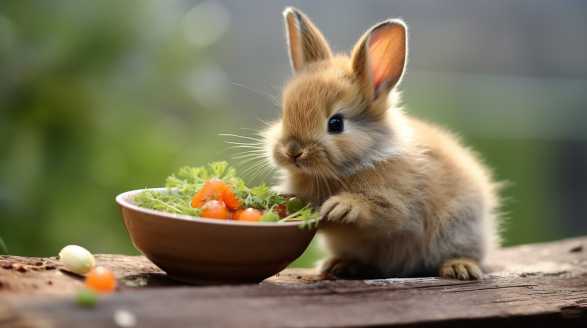
What Can Rabbits Not Eat
Introduction What can rabbits not eat? Have I got a tale to tell you today that will leave you on the edge of your seat! But little did I know that something as innocent as feeding rhubarb to my precious bunny could have such deadly consequences! Buckle up, my friends, because we’re about to dive […]
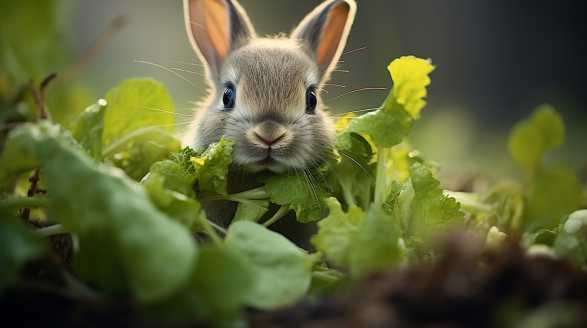
Can Rabbits Eat Spring Mix
Introduction Hey there fellow rabbit lovers! Are you wondering if spring mix is a suitable addition to your fluffy friend’s diet? we’ll be exploring the topic of whether rabbits can eat spring mix and how to safely incorporate it into their diet. We’ll cover everything from the dietary needs of baby rabbits to potential risks […]
